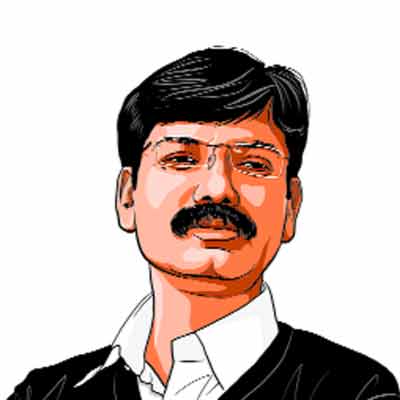Opinion The ‘suraksha’ story: How police encounters are justified in Uttar Pradesh
They are seen as an important part of the security narrative of the Yogi Adityanath government, which has created political capital for Yogi and BJP
 Police personnel guard as an ambulance carries the body of gangster-turned-politician Atiq Ahmed's son Asad Ahmed for his last rites at Kasari-Masari graveyard, in Prayagraj. (Photo: PTI)
Police personnel guard as an ambulance carries the body of gangster-turned-politician Atiq Ahmed's son Asad Ahmed for his last rites at Kasari-Masari graveyard, in Prayagraj. (Photo: PTI) On Thursday, an Uttar Pradesh Special Task Force police team announced that it had shot Asad Ahmed, the 19-year-old son of Atiq Ahmed, a former MP currently in jail for the murder of Raju Pal, an ex-MLA from BSP, in 2005. On Saturday night, Atiq Ahmed and his brother, Ashraf, were shot dead by assailants as they were being escorted by the police for a routine medical check-up. The killings took place on live TV. The STF claimed that Asad was among the shooters who killed Umesh Pal, an advocate who was also a witness in the Raju Pal murder case. A report in this newspaper says that the killing of Asad Ahmed and his aide, Ghulam Hussain, is Encounter No 183 since Yogi Adityanath became the Chief Minister of UP in March 2017. The police encounter has been a subject of intense discussion in UP. This supposed state action against alleged mafia and criminals has been widely condoned by large sections of the public.
Yogi Adityanath has been unapologetic about police encounters. In fact, he projects these acts of the state police as an expression of the “suraksha” he promised voters during the 2022 UP assembly election. He had assured the security of common people from land grabbers and criminals and promised to transform Uttar Pradesh into a peaceful society. His image as “bulldozer baba” — an epithet he gained for ordering that property belonging to people perceived by the state as history-sheeters, gangsters, and rioters be razed using bulldozers — was invoked to buttress this security agenda during the election campaign in 2022. Other BJP CMs have also followed the Yogi model against crime in their states. Police encounters were also cited to project Yogi as a CM who has zero tolerance for crime. On the ground, it has allowed the government to build the narrative that it is ruthless against criminals.
It has also helped the UP CM cultivate the image of a tough and effective chief minister beyond the borders of UP. Anecdotal evidence suggests that he has become an icon for BJP supporters in many Hindi-speaking states. “Woh sab theek kar denge” (He will set it all right) is a refrain one constantly hears in UP as one asks about Yogi, who is often referred to as Baba or Maharaj.
Yogi is not the first CM to build popular support on the ground through the effective implementation of law and order. Mayawati, who was CM four times, was also admired for her tough stance against the mafia and powerful gangsters. However, Yogi has gone a step further. Police encounters, despite criticism from civil rights activists and occasionally the courts, are justified as essential to further the governance agenda of state-building in UP. In this narrative, gangsters spoil the image of UP and derail development. Also, the elimination of gangsters is talked about as a necessary step to provide “suraksha” to the public. A peaceful environment, he argues, will attract investors to UP. This narrative has wide acceptance in UP.
The popularity of Yogi’s security narrative is also linked to the transformation of UP society, especially the growth of the urban middle-class, and economy, where land has become a precious commodity and an asset that also breeds insecurity. A section of the middle-class, and upper-caste Hindus also see the mafia through the prism of religion — that many of the dons are Muslims has coloured perceptions, especially of the middle class.
The major cities in UP — Agra, Aligarh, Kanpur, Lucknow, Allahabad and Banaras — have been expanding at a fast pace. The process of urbanisation even in small towns has accelerated, which has also transformed rural space around cities. Land value in qasbas and towns has increased. The expansion of highways has contributed to the increase in land value, including in villages near highways. The spread of the land mafia has only increased the insecurity of the propertied classes, who face harassment and humiliation from these criminals in their daily lives. It is this sense of insecurity among the middle classes that Yogi has tapped into with his “suraksha” narrative. Encounters and similar state actions are seen as the government sending a message to the mafia and land grabbers to keep off the land and property of common people.
Over the years, the “suraksha” plank has created enormous political capital for Yogi. The BJP continues to benefit from it in elections while Yogi’s popularity soars.
The writer is professor, Govind Ballabh Pant Social Science Institute, Allahabad






